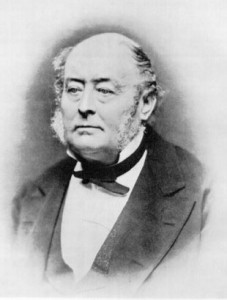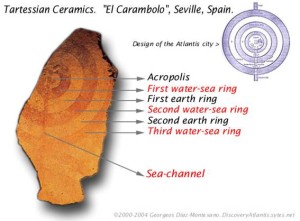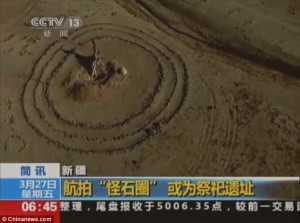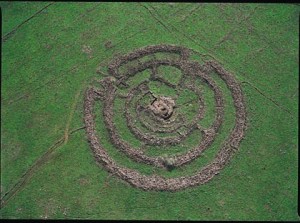Clieto
Bachofen, Johann, Jakob
 Johann Jakob Bachofen (1815-1887) was a Swiss antiquarian and anthropologist. He was very interested in ancient matriarchy and in that connection, he proposed that Clieto was the first queen of Atlantis, which, if correct, is possible evidence that in remote antiquity Atlantis was a matriarchy!
Johann Jakob Bachofen (1815-1887) was a Swiss antiquarian and anthropologist. He was very interested in ancient matriarchy and in that connection, he proposed that Clieto was the first queen of Atlantis, which, if correct, is possible evidence that in remote antiquity Atlantis was a matriarchy!
His views were expressed in his 1861 book, Das Mutterrecht[1344].
Teleguin, Sergey
Sergey Teleguin is a Russian professor of Philology and a leading advocate of the idea that the city of Tripura (Triple City) in Vedic tradition was the original inspiration behind Plato’s city of Atlantis. In support  of his contention he has outlined a number of parallels between Plato’s account and the sacred texts of India, the Puranas and Mahabharata, in an extensive English excerpt(a) from his 2005 Russian book, Anatomy of a Myth[1122].
of his contention he has outlined a number of parallels between Plato’s account and the sacred texts of India, the Puranas and Mahabharata, in an extensive English excerpt(a) from his 2005 Russian book, Anatomy of a Myth[1122].
A further claim by Teleguin is that the Popol Vuh, the sacred book of the Maya gives clears evidence that they came from the far north – Ultima Thule. He goes further and attributes a North Pole origin to both the Maya and the Indo-Europeans(b).
He has recently outlined his ideas further in an article for (Nov/Dec 2013) Issue 102 of Atlantis Rising magazine.
He recently reiterated, in an email, his view that Plato’s Atlantis story should only be accepted literally or not at all. It is difficult to accept that an academic could write such nonsense. He cannot be unaware that Plato’s narrative is composed of mythology, history and within the bounds of literary licence, some embellishment of his own. Otherwise, according to Teleguin, we are expected to believe that Clieto actually gave birth to five sets of male twins, that Athens fought a war before it existed and that Poseidon and Atlas were real people! The same absence of critical thinking allows people to believe that the world was created in seven days.
Sexual Undertones
Sexual Undertones in the Atlantis narrative have been identified by J. Warren Wells, who maintains that Clieto or Kleito in Greek is the diminutive of Kleitoris, which is rendered clitoris in English. He further contends that the name of her husband, Poseidon, can have its constituent elements, Pos and Eidon, translated as ‘penis idol’(a). His ideas have been supported by Ulf Erlingsson(b).
Sex at a more blatant level was achieved by John Grant with his Sex Secrets of Ancient Atlantis delivered with all the accuracy and sincerity we could expect from tabloid journalism.
David McMillin has an extensive article on sex in Atlantis(c), unfortunately the valueof his speculations are, in my view, marred by an over reliance on the ‘readings’ of Edgar Cayce.
(a) https://greekatlantis.warpco.com/Sexcentric.html (offline 1.07.14)
(b) See: https://web.archive.org/web/20190727102713/https://www.ireland-hotels.net/en/atlantisinireland.html
(c) See: https://web.archive.org/web/20180627092444/https://www.mcmillinmedia.com/atlantis-sex/
Poseidon
 Poseidon was one of the twelve Olympians of ancient Greek mythology. He was also the Greek god of the sea who was given the island of Atlantis as his realm. The Romans later knew Poseidon as Neptune. Herodotus (II.50.2) claimed that the Greek gods were imported from Egypt with a few exceptions including Poseidon. Some have suggested that the ancient Egyptian god Sobek was the equivalent of Poseidon, but the connection seems rather tenuous.
Poseidon was one of the twelve Olympians of ancient Greek mythology. He was also the Greek god of the sea who was given the island of Atlantis as his realm. The Romans later knew Poseidon as Neptune. Herodotus (II.50.2) claimed that the Greek gods were imported from Egypt with a few exceptions including Poseidon. Some have suggested that the ancient Egyptian god Sobek was the equivalent of Poseidon, but the connection seems rather tenuous.
>Eire Rautenberg has proposed that Poseidon was not originally a Greek god but instead came from the Libyans of North Africa(b).<
Some writers have suggested that Noah was to be equated with Poseidon. His symbol was a trident.
Poseidon is also credited with having been the first to tame horses. Others, such as Nienhuis, have equated Poseidon with Sidon referred to in Genesis 10:15.
The Phoenician sea god Melqart is frequently seen as the son of Poseidon whereas others, such as Jonas Bergman, consider them to be identical. The Nordic sea god Aegir is also seen as a mirror of Poseidon. In Portugal, Saint Bartholomew is considered a Christianised Poseidon, where statues of him are similar to those of Poseidon including a trident.
The Celtic god of the sea was known as Manannán Mac Lir who is frequently associated with the Isle of Man in the Irish Sea.
When the Greek gods divided the world among themselves, Poseidon received Atlantis as his share. He fell in love with a mortal, Clieto, who bore him five sets of twin boys, of whom Atlas was the firstborn and primus inter pares. Atlantis was then shared between them.
In December 2017, Anton Mifsud, Malta’s leading Atlantologist, published an intriguing suggestion(a) , when he pointed out that on the ceiling of the Sistine Chapel, painted by Neo-Platonist Michelangelo, something odd can be perceived in the central panel, known as The Creation of Adam. There, we find ‘god’ surrounded by five pairs of flightless ‘cherubs’. This is reminiscent of Poseidon’s five pairs of twin sons. Atlantis. However, Christian iconography invariably shows cherubs with wings, so it begs the question; why this departure from the norm? Mifsud contends that together with other aspects of the fresco, this depiction is closer to Plato’s ‘god’, Poseidon, than that of the Mosaic creator in Genesis!
(a) https://www.academia.edu/35425812/THE_CREATION_OF_ADAM_-_Genesis_or_Plato?auto=download
(b) Poseidon is not a Greek god! – Atlantisforschung.de (atlantisforschung-de.translate.goog) *
Kings of Atlantis
The Kings of Atlantis were, according to Plato, originally the sons of Poseidon and Cleito. They were ten in number and consisted of five sets of male twins. The firstborn was Atlas who was given authority over the others, each of whom controlled their own territory. Some commentators reacted with such incredulity to this story, that they have either dismissed this detail or in some cases the entire Atlantis tale as pure fantasy. Of course, it is highly improbable, if not virtually impossible to accept that Clieto had five sets of all-male twins. However, we are dealing here with a myth that is an echo of the legends of many other cultures describing their antediluvian origins. Lenormant & Chevallier wrote [424] of this over a hundred years ago:
“…The ten kingdoms of Atlantis are perpetuated in all the ancient traditions. ‘In the number given by the Bible for the Antediluvian patriarchs we have the first instance of a striking agreement with the traditions of various nations. Other nations, to whatever epoch they carry back their ancestors…are constant to the sacred number of ten… In Chaldea (Babylon), Berosus, writing in the third century BC, numerates ten Antediluvian kings whose fabulous reigns extended to thousands of years. The legends of the Iranian race commence with the reign of ten Peisdadien (Poseidon?) kings…. In India we meet with the nine Brahmadikas, who, with Brahma, their founder, make ten, and who are called the Ten Petris, or Fathers. The Chinese count ten emperors, partaking of the divine nature, before the dawn of historical time. The Germans believed in the ten ancestors of Odin, and the Arabs in the ten mythical kings of the Adites”.
Cosmas Indicopleustes, in the 6th century AD, contended[1245] that Atlantis was the Garden of Eden and that Plato’s 10 kings of Atlantis were the 10 generations between Adam and Noah!
It may be just a coincidence, but Plato tells us that the domain of Atlantis extended as far as Tyrrhenia (modern Tuscany), just south of which was Rome, a city, which according to legend was also founded by twin brothers, Romulus and Remus. It has been claimed that the story of their origins is a variation of the story in the Hindu epic Ramayana concerning the twin sons of king Sri Rama, Luva and Kusha(c).
In the same region, Sicily has the legend of the divine Palici twins (Palikoi in Greek).
>Aelian in his Natura Animalium has recorded [0619 xv.2] how the natives who live on the shores of ‘Ocean’ have a legend that tells of the Atlantean kings, who, to symbolise their authority from Poseidon, wore a crown reminiscent of the white band that ran around the forehead of the male ‘ram fish’ while their queens wore headgear made from the skins of ’marine ewes’.
“Ram-fishes, whose name has a wide circulation, although information about them is not very definite except in so far as displayed in works of art, spend the winter near the strait between Corsica and Sardinia and actually appear above water. And round about them swim dolphins of very great size.” (15.2)(f)
Although these animals have not been clearly identified, their size suggests a species of whale. I suggest that it was a fin whale which has a grey or white chevron marking on top of its head and is frequently found in the Strait of Bonifacio, between Corsica and Sardinia, at the southern end of the Pelagos Sanctuary.
“Fin whales, the second largest animal on the planet after blue whales, are represented in the Mediterranean by a resident population separated from the Atlantic.“(e)
So, it would appear obvious from this excerpt that Aelian did not have any doubt regarding the reality of Atlantis. Perhaps even more interesting is that Aelian seems to also associate these kings of Atlantis with Corsica and Sardinia. For me, this is compatible with a Central Mediterranean location for Atlantis.<
Although Babylon is supposed to have had ten kings before the Flood, it must be noted that they reigned successively rather than concurrently, as was the case in Atlantis.
Attention has been drawn to the fact that Manetho (c. 300 BC), the Egyptian historian called the first sequence of Egyptian god-kings ‘Auriteans’, which has been seen as suspiciously like a corruption of ‘Atlanteans‘.
Plato gives the names of the first ten kings as; Atlas, Gadeiros (Eumelos), Ampheres, Euaimon, Mneseos, Autochthon, Elasippos, Mestor, Azaes, Diaprepres (Critias 114b).
Some writers have attempted to link these names with specific regions; such as Atlas with Morocco, Eumelos (Gadeiros) with Gades (Cadiz) and Elasippos with Lisbon. Beyond these three there is very little agreement. Lewis Spence correctly points out “Plato expressly states that these names had been Egyptianised from the Atlantean language by the priest of Sais, and subsequently Hellenised in Critias, so that there is little hope that they were transmitted in anything like their original form.” Spence also commented on the similarity of the Phoenician gods and the early kings of Atlantis, an idea suggested earlier by Ignatius Donnelly.
Reginald Fessenden claimed to have identified at least six of Plato’s Atlantean king-list with names in the Caucasus.(d)
Even more distant locations were proposed by the French cartographer Guillaume Sanson (1633-1703), who generously distributed the Americas among the ten brothers, allocating Mexico to Atlas.
R. Cedric Leonard is convinced that Manetho’s list of Egyptian god-kings is in fact a list of the first kings of Atlantis and expands on this idea on his website(a). However, in his 1979 book, Quest for Atlantis[0130], Leonard has suggested that the kings of Atlantis were human-alien hybrids and that humans are the result of alien genetic experiments!!
Another site(b) identifies the kings of Atlantis with the pantheon of Phoenician gods, an idea first mooted by Ignatius Donnelly (part IV. chap. III). But Donnelly, also suggested, unconvincingly, that the gods of the Greeks were just the deified kings of Atlantis (part IV, chap. II), while it is also possible that they were just personifications of natural phenomena.
An unusual feature of the Atlantean kings is the meeting every fifth and sixth year. Plato explains this as a way of honouring odd and even numbers. However, Bacon & Galanopoulos suggest[263.152] that in fact, this may have been the result of an awareness of the eleven-year cycles of rains. I believe that this explanation is equally weak and the subject requires further investigation.
(a) https://web.archive.org/web/20170608084749/http:/www.atlantisquest.com:80/Hiero.html
(b) https://phoenicia.org/godidea.html#Atlantis
(c) https://vediccafe.blogspot.ie/2014/05/the-ramayana-in-roots-of-pre-christian.html
(d) The Deluged Civilisation of the Caucasus Isthmus [1012] (chap 3.29) *
(e) https://tethys.org/activities-overview/research/fin-whales/ *
Concentric Rings *
The Concentric Rings or other architectural features extracted by artists from Plato’s description of the capital of Atlantis have  continually fascinated students of the story and many have attempted to link them with similar ancient features found elsewhere in the world as evidence of a widespread culture. Stonehenge, Old Owstrey, Carthage and Syracuse have all been suggested, but such comparisons have never been convincing. Diaz-Montexano has recently published(a) an image of a fragment of pottery found near Seville in Spain that shows concentric circles and insists that it is a symbol of Atlantis. Ulf Erlingsson has made a similar claim regarding some concentric circles carved on a stone basin found at Newgrange in Ireland.
continually fascinated students of the story and many have attempted to link them with similar ancient features found elsewhere in the world as evidence of a widespread culture. Stonehenge, Old Owstrey, Carthage and Syracuse have all been suggested, but such comparisons have never been convincing. Diaz-Montexano has recently published(a) an image of a fragment of pottery found near Seville in Spain that shows concentric circles and insists that it is a symbol of Atlantis. Ulf Erlingsson has made a similar claim regarding some concentric circles carved on a stone basin found at Newgrange in Ireland.
Less well-known are the concentric stone circles that are to be found on the island of Lampedusa in the Strait of Sicily(b).
In 1969 two commercial pilots, Robert Brush and Trigg Adams photographed a series of large concentric circles in about three feet of water off the coast of Andros in the Bahamas. Estimates of the diameter of the circles range from 100 to 1,000 feet. Apparently, these rings are now covered by sand. It is hard to understand how such a feature in such very shallow water cannot be physically located and inspected. Richard Wingate in his book [0059] estimated the diameter at 1,000 yards. However, the rings described by Wingate were apparently on land, among Andros’ many swamps.
A recent (2023) report has drawn attention to the ancient rock art found on Kenya’s Mfangano Island where a number of concentric circles estimated as 4,000 years old can be seen(q).
Two papers presented to the 2005 Atlantis Conference on Melos describe how an asteroid impact could produce similar concentric rings, which, if located close to a coast, could be converted easily to a series of canals for seagoing vessels. The authors, Filippos Tsikalas, V.V. Shuvavlov and Stavros Papamarinopoulos gave examples of such multi-ringed concentric morphology resulting from asteroid impacts. Not only does their suggestion provide a rational explanation for the shape of the canals but would also explain the apparent over-engineering of those waterways.
At the same conference, the late Ulf Richter presented his idea [629.451], which included the suggestion that the concentric rings around the centre of the Atlantis capital had a natural origin. Richter has proposed that the Atlantis rings were the result of the erosion of an elevated salt dome that had exposed alternating rings of hard and soft rock that could be adapted to provide the waterways described by Plato.
Georgeos Diaz-Montexano has suggested that the ancient city under modern Jaen in Andalusia, Spain had a concentric layout similar to Plato’s description of Atlantis. In August 2016 archaeologists from the University of Tübingen revealed the discovery(i) of a Copper Age, Bell Beaker People site 50km east of Valencina near Seville, where the complex included a series of concentric earthwork circles.
A very impressive example of man-made concentric stone circles, known in Arabic as Rujm el-Hiri and in Hebrew as Gilgal Refaim(a), is to be found on the Golan Heights, now part of Israeli-occupied Syria. It consists of four concentric walls with an outer diameter of 160metres. It has been dated to 3000-2700 BC and is reputed to have been built by giants! Mercifully, nobody has claimed any connection with Atlantis. That is until 2018 when Ryan Pitterson made just such a claim in his book, Judgement of the Nephilim[1620].
Jim Allen in his latest book, Atlantis and the Persian Empire[877], devotes a well-illustrated chapter to a discussion of a number of ‘circular cities’ that existed in ancient Persia and which some commentators claim were the inspiration for Plato’s description of the city of Atlantis. These include the old city of Firuzabad which was divided into 20 sectors by radial spokes as well as Ecbatana and Susa, both noted by Herodotus to have had concentric walls. Understandably, Allen, who promotes the idea of Atlantis in the Andes, has pointed out that many sites on the Altiplano have hilltops surrounded by concentric walls. However, as he seems to realise that to definitively link any of these locations with Plato’s Atlantis a large dollop of speculation was required.
Rodney Castleden compared the layout of Syracuse in Sicily with Plato’s Atlantis noting that the main city “had seen a revolution in its defensive works, with the building of unparalleled lengths of circuit walls punctuated by numerous bastions and towers, displaying the city-state’s power and wealth. The three major districts of the city, Ortygia, Achradina and Tycha, were surrounded by three separate circuit walls; Ortygia itself had three concentric walls, a double wall around the edge and an inner citadel”.[225.179]
Dale Drinnon has an interesting article(d) on the ‘rondels’ of the central Danubian region, which number about 200. Some of these Neolithic features have a lot in common with Plato’s description of the port city of Atlantis. The ubiquity of circular archaeological structures at that time is now quite clear, but they do not demonstrate any relationship with Atlantis.
The late Marcello Cosci based his Atlantis location on his interpretation of aerial images of circular features on Sherbro Island, but as far as I can ascertain this idea has gained little traction.
One of the most remarkable natural examples of concentric features is to be found in modern Mauritania and is known as the Richat Structure or Guelb er Richat. It is such a striking example that it is not surprising that some researchers have tried to link it with Atlantis. Robert deMelo and Jose D.C. Hernandez(o) are two advocates along with George S. Alexander & Natalis Rosen who were struck by the similarity of the Richat feature with Plato’s description and decided to investigate on the ground. Instability in the region prevented this until late 2008 when they visited the site, gathering material for a movie. The film was then finalised and published on their then newly established website in 2010(l), where the one hour video in support of their thesis can be freely downloaded(m).
In 2008, George Sarantitis put forward the idea that the Richat Structure was the location of Atlantis, supporting his contention with an intensive reappraisal of the translation of Plato’s text(n). He developed this further in his Greek language 2010 book, The Apocalypse of a Myth[1470] with an English translation currently in preparation.
However, Ulf Richter has pointed out that Richat is too wide (35 km), too elevated (400metres) and too far from the sea (500 km) to be seriously considered as the location of Atlantis.
A dissertation by Oliver D.Smith has suggested(e) the ancient site of Sesklo in Greece as the location of Atlantis, citing its circularity as an important reason for the identification. However, there are no concentric walls, the site is too small and most importantly, it’s not submerged. Smith later decided that the Atlantis story was a fabrication!(p)
Brad Yoon has claimed that concentric circles are proof of the existence of Atlantis, an idea totally rejected by Jason Colavito(j).
In March 2015, the UK’s MailOnline published a generously illustrated article(g) concerning a number of sites with unexplained concentric circles in China’s Gobi Desert. The article also notes some  superficial similarities with Stonehenge. I will not be surprised if a member of the lunatic fringe concocts an Atlantis theory based on these images. (see right)
superficial similarities with Stonehenge. I will not be surprised if a member of the lunatic fringe concocts an Atlantis theory based on these images. (see right)
Paolo Marini has written Atlantide:Nel cerchio di Stonehenge la chiave dell’enigma (Atlantis: The Circle is the Key to the enigma of Stonehenge) [0713]. The subtitle refers to his contention that the concentric circles of Atlantis are reflected in the layout of Stonehenge!
In 2011 Shoji Yoshinori offered the suggestion that Stonehenge was a 1/24th scale model of Atlantis(f). He includes a fascinating image in the pdf.
This obsession with concentricity has now extended to the interpretation of ancient Scandinavian armoury in particular items such as the Herzsprung Shield(c).
For my part, I wish to question Plato’s description of the layout of Atlantis’ capital city with its vast and perfectly engineered concentric alternating bands of land and sea. This is highly improbable as the layout of cities is invariably determined by the natural topography of the land available to it(h). Plato is describing a city designed by and for a god and his wife and as such his audience would expect it to be perfect and Plato did not let them down. I am therefore suggesting that those passages have been concocted within the parameters of ‘artistic licence’ and should be treated as part of the mythological strand in the narrative, in the same way, that we view the ‘reality’ of Clieto’s five sets of male twins or even the physical existence of Poseidon himself.
Furthermore, Plato was a follower of Pythagoras, who taught that nothing exists without a centre, around which it revolves(k). A concept which may have inspired him to include it in his description of Poseidon’s Atlantis.
(b) Megalithic Lampedusa (archive.org)
(c) https://www.parzifal-ev.de/index.php?id=20
(d) See: Archive 3595
(e) https://atlantipedia.ie/samples/archive-3062/
(f) https://www.pipi.jp/~exa/kodai/kaimei/stonehenge_is_small_atrantis_eng.pdf
(i) First Bell Beaker earthwork enclosure found in Spain | ScienceDaily (archive.org) *
(j) https://www.jasoncolavito.com/blog/rings-of-power-do-concentric-circles-prove-atlantis-real
(k) Pythagoras and the Mystery of Numbers (archive.org)
(l) Visiting Atlantis | Gateway to a lost world (archive.org)
(m) https://web.archive.org/web/20171022134926/https://visitingatlantis.com/Movie.html
(n) https://platoproject.gr/system-wheels/ https://platoproject.gr/page13.html (offline Nov.2015)
(o) https://blog.world-mysteries.com/science/a-celestial-impact-and-atlantis/ (item 11)
(p) https://shimajournal.org/issues/v10n2/d.-Smith-Shima-v10n2.pdf
Evenor
Evenor and his wife Leucippe were the parents of Clieto who married Poseidon, who in turn became the parents of the first ten kings of Atlantis (Critias 113c-114c).
One fundamentalist website(a) manages to give both Evenor and Leucippe a sex change, identifying the former as the biblical Eve and ‘her’ partner as Lucifer!
(a) https://genesisveracityfoundation.com/2013/02/08/platos-atlantis-story-covers-biblical-history-garden-of-eden-to-the-exodus-out-of-egypt/ (offline 11/2/14)

